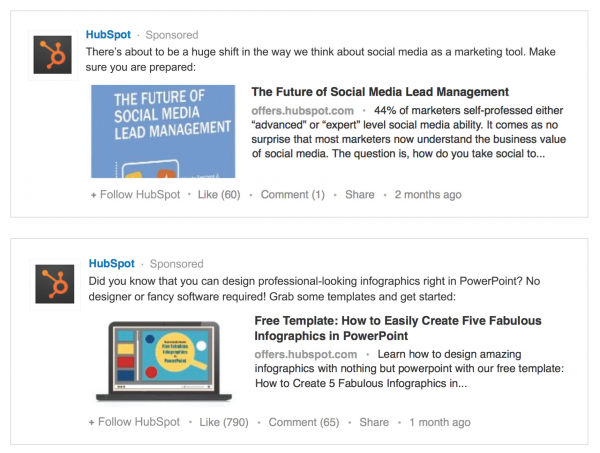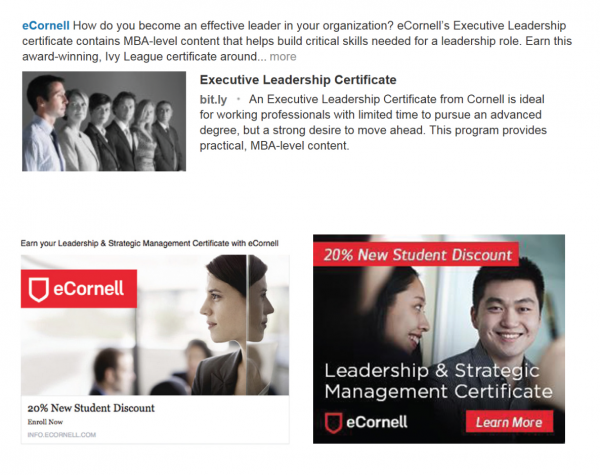The good, the bad, and the ugly (but mostly good) wrapped up in a semi-formal LinkedIn ads review
Advertising your business on social media, particularly one like LinkedIn, is a tricky process. What inspired me to dig into LinkedIn ads, is that so many of our clients are now surfing the social media ad game, and thus, so are we! If you publish content for professionals, and host professional events, LinkedIn could be a good place to buy ads.
Like buying any ad, you want to know where your money is going. If someone clicks, how likely will it convert into a lead? And like any PPC platform, half of it is in your hands to write great copy. The other half is in the audience. And from what we’ve heard, LinkedIn is superior to most networks when it comes to targeting. They may not have as great of a network as Facebook or Twitter, or even the best ad platform, but their targeting is razor sharp.
[text_ad]
LinkedIn Ads Review: The Pros
Okay, so what’s so great about LinkedIn ads?
First, LinkedIn is super tangible and easy advertisement tool. The “pay-per-click” method allows its users to break down the audience they’re seeking. For LinkedIn in particular, this feature rules. It’s inexpensive, and you get to choose which format you want to do:
- Text and image ads
- Video ads
- Text only ads
… and who you want to reach, with very specific parameters, like:
- Location
- Company Name (current employer listed on member’s profile)
- Company Industry
- Company Size
- Job Title
- Job Function
- Job Seniority
- Member Skills
- Member Schools
- Degrees
- Fields of Study
- Member Groups – up to 100 active groups
- Member Gender
- Member Age
This is not like buying a quarter page in a magazine and hoping for the best. This is true targeting. Isn’t online advertising grand?
Here’s an example of how it works: if you are seeking out a marketing director at an arts organizations in the Manhattan area, you can choose the industry, location, type of employee, etc., and you just pay for each click (hence the name), and you choose the price you’re willing to pay for that click. After looking into it, everyone seems to say you should stick to the $2 minimum bid.
Another type of advertisement you can work with is Sponsored Ad Updates, (their form of native ads, but not really) where your company page shares content with its followers. In addition to reaching your connections, you’ll also get gain visibility from others outside of your network. While you do have to pay per click, it doesn’t cost you anything if your update is shared by somebody else (#sweet).
Hubspot used this method and said they got “400% more leads within their target audience than lead generation efforts on other platforms.”

And if you are familiar with Google Adwords, you’re good to go with LinkedIn ads. The formats used on both sites are nearly identical to one another. Even if you’re not familiar with the concept, it’s still a very simple and easy way to do some marketing.
According to Jeff Rajeck, who says he spent $100k on LinkedIn ads in a year, “LinkedIn has the most accurate targeting of any ad platform. Sure, Google has wider reach and Facebook has more categories, but for pure targeting, nothing beats LinkedIn. This is because LinkedIn users input the targeting data themselves; if they work in a bank, they put in their profile that they work in a bank. ”
Also, there used to be no remarking tools, but they’ve since launched Lead Accelerator, which seems to be their version of remarketing. Cornell University used it to increase enrollment in their online certification programs and said that landing page conversion rates were 2x higher than normal marketing campaigns, and cost per lead was 3x lower than traditional retargeting.

Andrew Hickey, Director of Digital Marketing at eCornell says, “I think one key thing Lead Accelerator does right is this – as soon as a prospect engages and shows interest in a particular program, they start receiving sequenced messaging that’s relevant to the specific program they’ve shown interest in. You can see the impact of this in the performance and you can see it in the quality of each lead.”
The American Institute of CPAs (AICPA) is another success story, specifically for membership-driven businesses. They promoted a LinkedIn group via LinkedIn Display Ads and saw 40% growth in group membership in the first half of 2013 to 54,000 group members. Because of this group, LinkedIn is the top driver of traffic to AICPA website, according to a case study.
LinkedIn Ads Review: The Cons
You didn’t think it was all roses, did you?
First is the cost. Your minimum cost-per-click is $2, and you must spent $10 per day. But if you buy Google Ads, you’re probably used to this anyway. And if you’re buying ads, you’re probably spending more than $10 a day anyway. So let’s move on.
The biggest complaint I’ve heard is that is has a bad click-through rate. Now, I tend to believe that bad click-through rates are not the fault of the advertising platform, but of the advertiser, but one marketer compared a 1 out of 500 click-through rate on LinkedIn to 1 to 250 on Facebook and 1 to 100 on Twitter. However, this same marketer said LinkedIn had higher conversion rates. So again, let’s move on.
Finally, the last global complaint I came across was the conversion tracking that LinkedIn uses. It’s unlike other social media websites; you can’t really tell what ads are doing best, and who exactly is in your audience. You don’t receive the name or email address of the person that clicked on your page. Oh! You do, however, get a URL to the page that can be used to track through web analytics…but according to what we’ve heard, it’s a pretty annoying process.
It’s also going to be difficult for you to figure out where to go next with your ads because you have little information coming back from your audience. How will you know what to do next when optimizing your ads? Looking into a crystal ball is one option.
However, there are several certified LinkedIn ad platforms that can give you advanced analytics and tracking, like:
On a recent Tweetchat, I got into LinkedIn ads and one person highly recommended AdStage. Another said, “Adstage is great. Not the best per se, but definitely the best for the money.” I didn’t hear anything about the others, so if I have to give you a heresy recommendation, I’ll go with that.
And here’s a story I thought was worth sharing. Recently in a SIPA forum, a publisher left their unofficial review of Linkedin, in regards to event marketing on the platform:
We’ve tried about all [the social networks]. LinkedIn is the obvious target. We’ve posted directly into the Discussion section of groups and into the Promotion section. We get very few trackable orders. We’ve even worked with Group owners to get our posts to be Manager’s Choice and be posted at the top of the forum for days/weeks. Limited success. It’s weird – 27,000 targeted professionals in a niche group and you can only snag a few orders? I’d be curious what others are getting on LinkedIn. I have yet to heard of ANYONE that posts into a LinkedIn group and gets 20-200 registrations to their paid conference/workshop/forum. I’ve never heard anyone say, “LinkedIn is our primary source of orders.” I have heard of people having success offering free ebooks/premiums and building decent numbers for ezine signups. But those same people also say there’s a very large percentage of overseas takers, that they never convert to buyers.
Not a grand Linkedin ad review, but we’d be interested to hear how you’ve used their ad platform, and what your results have been.
If you’re a B2B publisher, LinkedIn would appear to be the social network to invest in. But is it all job seekers, and self-promoters? Or are people making purchases there too? Leave a comment and let us know.


